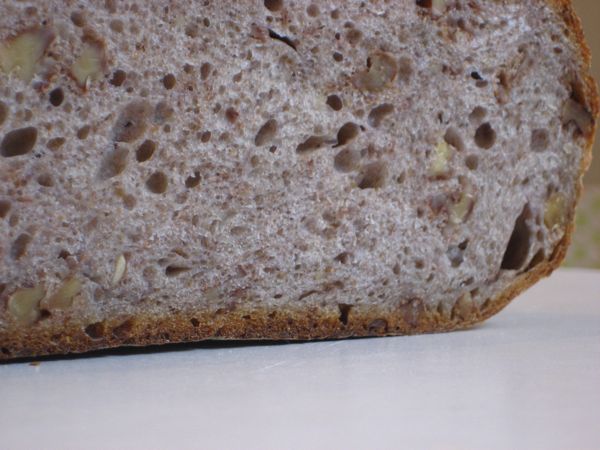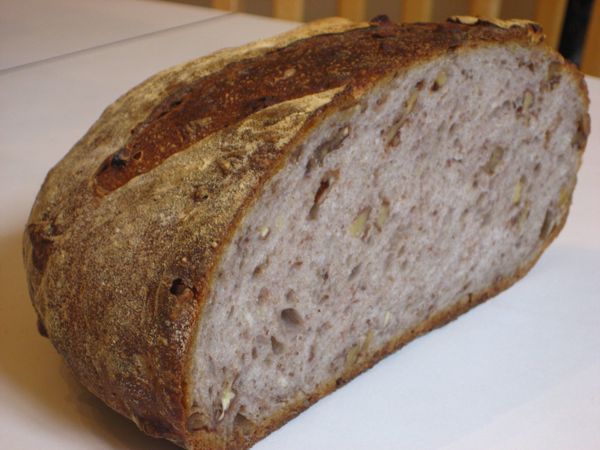This is the next in a series of blog posts, regarding my quest to reproduce Acme Bakery's Walnut Levain. See:
and
I think I'm pretty much there. My loaf is quite large now, because we like it. There are two preferments, one "old dough" (yeast raised) and one a sour sponge for flavor. The loaf itself is basically yeast raised.
Day 0, Evening
Sour Sponge:
- 3/4 cup rye flour
- 3/4 cup bread flour
- 1 and 1/2 cups warm water
- 2-3 tablespoons active liquid sour culture ("enough")
Old Dough Preferment
- 1 small ball old dough from any white (or mostly white) yeast-raised bread. I use a ball about 1 1/2 inches across, previously frozen (see: this post).
- 1/3 cup warm water
- enough bread flour to make a stiff dough (3/4 cup to 1 cup)
Thaw the old dough, if necessary, break it up into the warm water and let soften. Mix in the flour, knead to mix thoroughly (you don't care about gluten development at this point).
Let both preferments stand overnight, covered, at room temperature.
Day 1, Morning
Second Stage Old Dough Preferment
- previous old-dough preferment
- 1/3 cup warm water
- enough bread flour to make a stiff dough (1 cup to 1 1/4 cups, probably)
Repeat the operation from the first stage: break up the now-risen old-dough preferment into the warm water, let soften. Mix in flour to make a stiff dough, knead to mix thoroughly.
Let this new old-dough preferment stand for another 4 hours or so, until soft and well-risen.
At this point the sour sponge should have had 12 hours or so to ferment, and should be well ripened, active and bubbly. When the old-dough preferment is also well risen, place BOTH preferments into the fridge for at least an hour.
Day 1, Afternoon
Now we're going to make up dough. Take the preferments out of the fridge and let them warm up, ideally to room temperature.
- sour sponge preferment
- old-dough preferment
- 1 cup warm water (this might be QUITE warm, since you're working with cool preferments, but not so hot as to kill anything of course)
- 1/2 to 1 tsp active dry yeast (I use a scant half tsp of "instant" which seems to be more vigorous than "active") depending on temperature (use more if cooler)
- 1 tablespoon salt
- sufficient bread flour to make a moist dough (about 3 cups, probably)
- 2 to 2 1/2 cups coarsely chopped walnuts
Set aside all but 1/2 a cup of the chopped walnuts, and chop that half cup up Very Fine. I chopped mine to the consistency of very coarse sand (with a few large bits, consistency is not required).
Proof your yeast in a little bit of the warm water (which may be cooler than the rest of the water). Break the old-dough preferment up into a large bowl, and add the rest of the water, heated up as needed to bring the dough temperature up to at least room temperature (i.e. Quite Warm if your preferments are still cool, and Slightly Warm if everything is at room temperature), let soften.
Mix in the sour sponge, and stir well. You may still have some soft lumps of old dough preferment at this point.
Incorporate enough flour to make a wet dough. You're shooting for dough that will stick to the board and to your hands, but not excessively. I'd say more than 65% hydration, but less than 70%. I knead it by slapping the dough down on the board so it sticks, pull it out like taffy toward me, fold it away from me over the stuck down part. Scoop it off the board with my hands, turn 90 degrees. Repeat. It's sticky enough for that process, but not crazily sticky.
I mix thoroughly in the bowl, by hand, adding 1/3 of a cup of flour and the mixing 40-50 strokes, add the next 1/3 cup, etc. This gives some gluten development in the bowl.
Mix in the salt before it's too hard to stir, but before you've incorporated all the flour. Keep going until you can't stir any more, or until you've got enough flour worked in (that is, it's ok if you can't stir a 70 percent hydration dough by hand, not everyone can! The point is, get the salt in there before you can't stir and have to start kneading).
The last thing before you tip it out to knead, mix in that half cup of finely chopped walnuts.
Knead until it's pretty well developed. I only kneaded about 10 minutes. You don't need TOO much work to get good gluten development at this point, since your preferments are well developed; and if you use my (actually Joe Ortiz') technique of mixing in the bowl a lot, you're pretty well developed by the time you dump it out. Windowpaning will be hard with all the walnut bits, but the dough should want to windowpane even if the walnut won't let it!
Knead in the rest of the walnuts at this point, just to get them evenly distributed in the dough.
Bulk rise an hour and a half or so (until it poke tests). This last loaf I made, my dough was frankly too cold, since I didn't have time to warm my preferments up enough (I forgot about them!) so I did a couple of stretch and folds to warm more evening, and my bulk rise was more like 3 hours.
Shape into a boule and drop into a banneton. Final rise until poke-test. Expect about an hour.
Bake at 450F for one hour, with steam for the first 10 minutes. The crust winds up quite dark brown.
Remarks
The key to getting a more or less evenly purple crumb seems to be kneading with the finely chopped walnuts in. Adding them after kneading doesn't seem to have an effect on flavor, but does make the purple color very blotchy and uneven. (see previous posts)
I make have overbaked this last loaf, I want the dark crust, but the crumb seems a trifle too dry.
At this point I am really quite happy with my imitation of Acme's bread. It's not a perfect copy, but it has all the properties that I like about the Acme product, and it's extremely tasty (especially toasted). Also, my version is Quite Big, this thing is about a 3 pound boule, so there's lot of bread to eat and even give some away!
Pictures
There's plenty of pictures of previous variations in the earlier posts, so this is really just about showing the color of the crumb and of the crust:


- amolitor's Blog
- Log in or register to post comments
Nice crumb crust, color. and nice photos. I can only imagine the wonderful flavor.
Ray